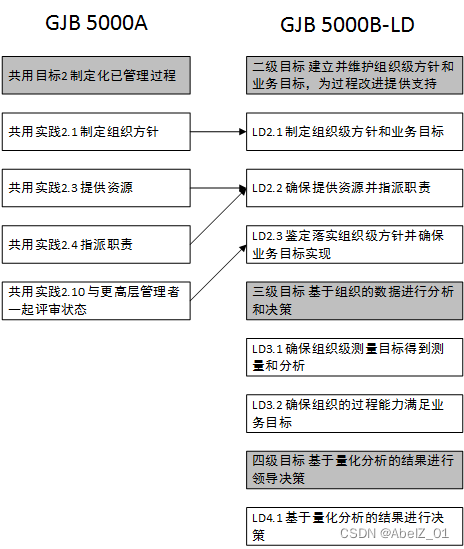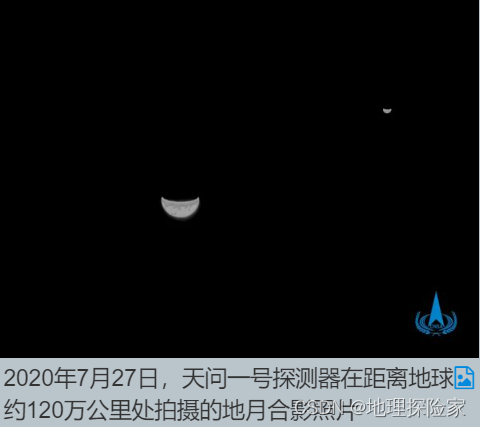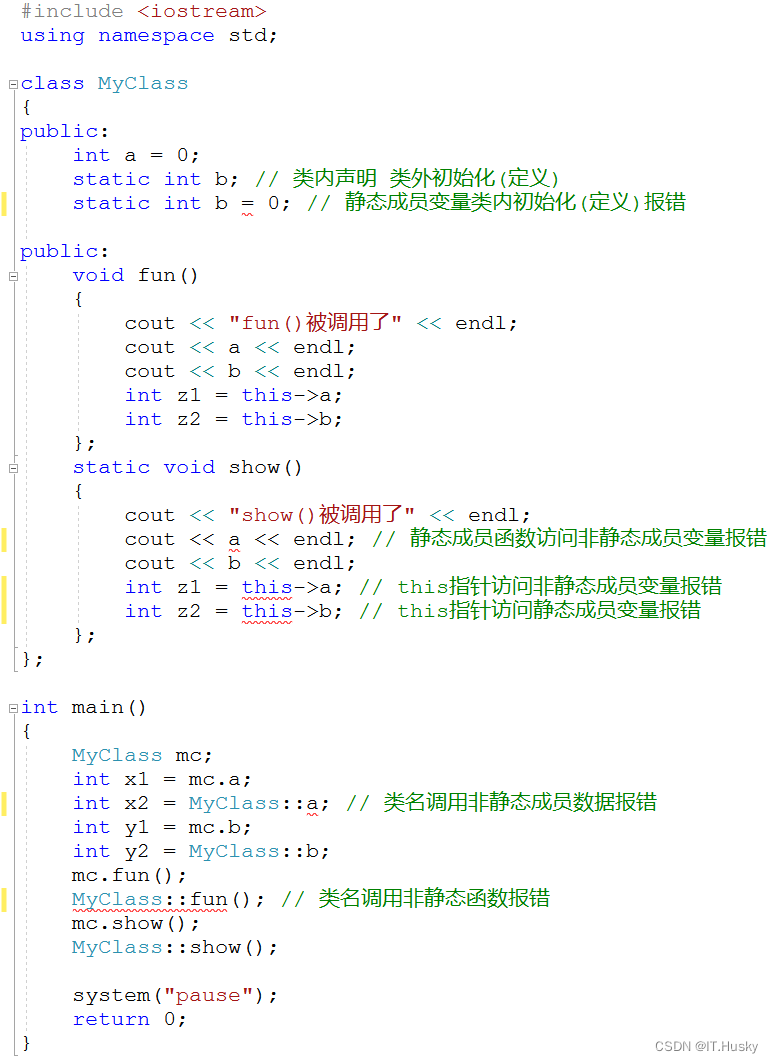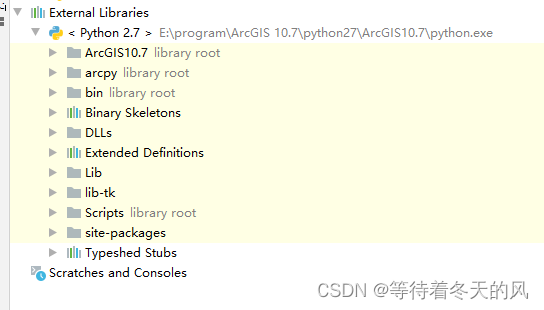此系列属于胡寿松《自动控制原理题海与考研指导》(第三版)习题精选,仅包含部分经典习题,需要完整版习题答案请自行查找,本系列属于知识点巩固部分,搭配如下几个系列进行学习,可用于期末考试和考研复习。
自动控制原理(第七版)知识提炼
自动控制原理(第七版)课后习题精选
自动控制原理(第七版)附录MATLAB基础
第九章:线性系统的状态空间分析与综合
Example 9.16
已知系统状态方程为:
x
˙
(
t
)
=
[
λ
1
0
0
0
λ
0
0
0
0
σ
1
0
0
0
σ
]
x
(
t
)
\dot{x}(t)=\begin{bmatrix} \lambda & 1 & 0 & 0\\ 0 & \lambda & 0 & 0\\ 0 & 0 & \sigma & 1\\ 0 & 0 & 0 & \sigma \end{bmatrix}x(t)
x˙(t)=⎣⎢⎢⎡λ0001λ0000σ0001σ⎦⎥⎥⎤x(t)
试求在初始条件
x
(
0
)
=
[
2
0
1
1
]
T
x(0)=\begin{bmatrix}2 & 0 & 1 & 1\end{bmatrix}^T
x(0)=[2011]T时的系统响应。
解:
系统矩阵为约当型,因此其状态转移矩阵为:
Φ
(
t
)
=
e
A
t
=
[
e
λ
t
t
e
λ
t
0
0
0
e
λ
t
0
0
0
0
e
σ
t
t
e
σ
t
0
0
0
e
σ
t
]
\Phi(t)={\rm e}^{At}=\begin{bmatrix} {\rm e}^{\lambda{t}} & t{\rm e}^{\lambda{t}} & 0 & 0\\ 0 & {\rm e}^{\lambda{t}} & 0 & 0\\ 0 & 0 & {\rm e}^{\sigma{t}} & t{\rm e}^{\sigma{t}}\\ 0 & 0 & 0 & {\rm e}^{\sigma{t}} \end{bmatrix}
Φ(t)=eAt=⎣⎢⎢⎡eλt000teλteλt0000eσt000teσteσt⎦⎥⎥⎤
因此,在初始条件
x
(
0
)
x(0)
x(0)时的系统响应为:
x
(
t
)
=
Φ
(
t
)
x
(
0
)
=
[
e
λ
t
t
e
λ
t
0
0
0
e
λ
t
0
0
0
0
e
σ
t
t
e
σ
t
0
0
0
e
σ
t
]
[
2
0
1
1
]
=
[
2
e
λ
t
0
e
σ
t
(
1
+
t
)
e
σ
t
]
x(t)=\Phi(t)x(0)=\begin{bmatrix} {\rm e}^{\lambda{t}} & t{\rm e}^{\lambda{t}} & 0 & 0\\ 0 & {\rm e}^{\lambda{t}} & 0 & 0\\ 0 & 0 & {\rm e}^{\sigma{t}} & t{\rm e}^{\sigma{t}}\\ 0 & 0 & 0 & {\rm e}^{\sigma{t}} \end{bmatrix}\begin{bmatrix} 2\\ 0\\ 1\\ 1 \end{bmatrix}= \begin{bmatrix} 2{\rm e}^{\lambda{t}}\\ 0\\ {\rm e}^{\sigma{t}}(1+t)\\ {\rm e}^{\sigma{t}} \end{bmatrix}
x(t)=Φ(t)x(0)=⎣⎢⎢⎡eλt000teλteλt0000eσt000teσteσt⎦⎥⎥⎤⎣⎢⎢⎡2011⎦⎥⎥⎤=⎣⎢⎢⎡2eλt0eσt(1+t)eσt⎦⎥⎥⎤
Example 9.17
已知系统状态方程为:
x
˙
(
t
)
=
[
−
1
1
0
0
−
1
0
0
0
−
2
]
x
(
t
)
+
[
0
1
4
]
u
(
t
)
,
x
(
0
)
=
[
1
2
1
]
\dot{x}(t)=\begin{bmatrix} -1 & 1 & 0\\ 0 & -1 & 0\\ 0 & 0 & -2 \end{bmatrix}x(t)+\begin{bmatrix} 0\\ 1\\4 \end{bmatrix}u(t),x(0)=\begin{bmatrix} 1\\ 2\\ 1 \end{bmatrix}
x˙(t)=⎣⎡−1001−1000−2⎦⎤x(t)+⎣⎡014⎦⎤u(t),x(0)=⎣⎡121⎦⎤
试求系统在单位阶跃输入作用下的时间响应。
解:
由于系统矩阵是约当型,因此状态转移矩阵
Φ
(
t
)
\Phi(t)
Φ(t)为:
Φ
(
t
)
=
e
A
t
=
[
e
−
t
t
e
−
t
0
0
e
−
t
0
0
0
e
−
2
t
]
\Phi(t)={\rm e}^{At}=\begin{bmatrix} {\rm e}^{-t} & t{\rm e}^{-t} & 0\\ 0 & {\rm e}^{-t} & 0\\ 0 & 0 & {\rm e}^{-2t} \end{bmatrix}
Φ(t)=eAt=⎣⎡e−t00te−te−t000e−2t⎦⎤
当输入为单位阶跃函数时,根据
x
(
t
)
=
e
A
t
x
(
0
)
+
∫
0
t
e
A
t
b
u
(
t
−
τ
)
d
τ
x(t)={\rm e}^{At}x(0)+\int_0^t{\rm e}^{At}bu(t-\tau){\rm d}\tau
x(t)=eAtx(0)+∫0teAtbu(t−τ)dτ
可得:
x
(
t
)
=
[
e
−
t
t
e
−
t
0
0
e
−
t
0
0
0
e
−
2
t
]
[
1
2
1
]
+
∫
0
t
(
[
e
−
τ
τ
e
−
τ
0
0
e
−
τ
0
0
0
e
−
2
τ
]
[
0
1
4
]
)
d
τ
=
[
e
−
t
+
2
t
e
−
t
2
e
−
t
e
−
2
t
]
+
∫
0
t
[
τ
e
−
τ
e
−
τ
4
e
−
2
τ
]
d
τ
=
[
1
+
t
e
−
t
1
+
e
−
t
2
−
e
−
2
t
]
\begin{aligned} x(t)&=\begin{bmatrix} {\rm e}^{-t} & t{\rm e}^{-t} & 0\\ 0 & {\rm e}^{-t} & 0\\ 0 & 0 & {\rm e}^{-2t} \end{bmatrix}\begin{bmatrix} 1\\2\\1 \end{bmatrix}+\int_0^t\left( \begin{bmatrix} {\rm e}^{-\tau} & \tau{\rm e}^{-\tau} & 0\\ 0 & {\rm e}^{-\tau} & 0\\ 0 & 0 & {\rm e}^{-2\tau} \end{bmatrix}\begin{bmatrix} 0\\1\\4 \end{bmatrix} \right){\rm d}\tau\\\\ &=\begin{bmatrix} {\rm e}^{-t}+2t{\rm e}^{-t}\\ 2{\rm e}^{-t}\\ {\rm e}^{-2t} \end{bmatrix}+\int_0^t\begin{bmatrix} \tau{\rm e}^{-\tau}\\ {\rm e}^{-\tau}\\ 4{\rm e}^{-2\tau} \end{bmatrix}{\rm d}\tau=\begin{bmatrix} 1+t{\rm e}^{-t}\\ 1+{\rm e}^{-t}\\ 2-{\rm e}^{-2t} \end{bmatrix} \end{aligned}
x(t)=⎣⎡e−t00te−te−t000e−2t⎦⎤⎣⎡121⎦⎤+∫0t⎝⎛⎣⎡e−τ00τe−τe−τ000e−2τ⎦⎤⎣⎡014⎦⎤⎠⎞dτ=⎣⎡e−t+2te−t2e−te−2t⎦⎤+∫0t⎣⎡τe−τe−τ4e−2τ⎦⎤dτ=⎣⎡1+te−t1+e−t2−e−2t⎦⎤
【单位阶跃响应曲线】

Example 9.18
已知系统状态方程如下:
- x ˙ ( t ) = [ − a 0 0 − b ] x ( t ) + [ 1 b − a 1 a − b ] u ( t ) \dot{x}(t)=\begin{bmatrix}-a & 0\\0 & -b\end{bmatrix}x(t)+\begin{bmatrix}\displaystyle\frac{1}{b-a}\\\displaystyle\frac{1}{a-b}\end{bmatrix}u(t) x˙(t)=[−a00−b]x(t)+⎣⎢⎡b−a1a−b1⎦⎥⎤u(t);
- x ˙ ( t ) = [ 0 1 − a b − ( a + b ) ] x ( t ) + [ 0 1 ] u ( t ) \dot{x}(t)=\begin{bmatrix}0 & 1\\-ab & -(a+b)\end{bmatrix}x(t)+\begin{bmatrix}0\\1\end{bmatrix}u(t) x˙(t)=[0−ab1−(a+b)]x(t)+[01]u(t);
设 a ≠ b , x ( 0 ) = 0 a≠b,x(0)=0 a=b,x(0)=0。试求当输入信号 u ( t ) u(t) u(t)分别为单位脉冲、单位阶跃、单位斜坡信号时系统的状态轨线。
解:
非齐次状态方程解的形式为:
x
(
t
)
=
e
A
t
x
(
0
)
+
∫
0
t
e
A
τ
b
u
(
t
−
τ
)
d
τ
x(t)={\rm e}^{At}x(0)+\int_0^t{\rm e}^{A\tau}bu(t-\tau){\rm d}\tau
x(t)=eAtx(0)+∫0teAτbu(t−τ)dτ
【系统1】
由于
e
A
t
=
L
−
1
[
(
s
I
−
A
)
−
1
]
=
L
−
1
[
1
s
+
a
0
0
1
s
+
b
]
=
[
e
−
a
t
0
0
e
−
b
t
]
{\rm e}^{At}=L^{-1}[(sI-A)^{-1}]=L^{-1}\begin{bmatrix} \displaystyle\frac{1}{s+a} & 0\\ 0 & \displaystyle\frac{1}{s+b} \end{bmatrix}=\begin{bmatrix} {\rm e}^{-at} & 0\\ 0 & {\rm e}^{-bt} \end{bmatrix}
eAt=L−1[(sI−A)−1]=L−1⎣⎢⎡s+a100s+b1⎦⎥⎤=[e−at00e−bt]
当
u
(
t
)
u(t)
u(t)为单位脉冲信号时:
x
δ
(
t
)
=
∫
0
t
[
e
−
a
τ
0
0
e
−
b
τ
]
[
1
b
−
a
1
a
−
b
]
δ
(
t
−
τ
)
d
τ
=
[
1
b
−
a
e
−
a
t
1
a
−
b
e
−
b
t
]
x_{\delta}(t)=\int_0^t\begin{bmatrix} {\rm e}^{-a\tau} & 0\\ 0 & {\rm e}^{-b\tau} \end{bmatrix}\begin{bmatrix} \displaystyle\frac{1}{b-a}\\ \displaystyle\frac{1}{a-b} \end{bmatrix}\delta(t-\tau){\rm d}\tau=\begin{bmatrix} \displaystyle\frac{1}{b-a}{\rm e}^{-at}\\ \displaystyle\frac{1}{a-b}{\rm e}^{-bt} \end{bmatrix}
xδ(t)=∫0t[e−aτ00e−bτ]⎣⎢⎡b−a1a−b1⎦⎥⎤δ(t−τ)dτ=⎣⎢⎡b−a1e−ata−b1e−bt⎦⎥⎤
当
u
(
t
)
u(t)
u(t)为单位阶跃信号时:
x
u
(
t
)
=
∫
0
t
[
e
−
a
τ
0
0
e
−
b
τ
]
[
1
b
−
a
1
a
−
b
]
⋅
1
(
t
−
τ
)
d
τ
=
∫
0
t
[
1
b
−
a
e
−
a
τ
1
a
−
b
e
−
b
τ
]
d
τ
=
[
1
a
(
b
−
a
)
(
1
−
e
−
a
t
)
1
b
(
a
−
b
)
(
1
−
e
−
b
t
)
]
x_u(t)=\int_0^t\begin{bmatrix} {\rm e}^{-a\tau} & 0\\ 0 & {\rm e}^{-b\tau} \end{bmatrix}\begin{bmatrix} \displaystyle\frac{1}{b-a}\\ \displaystyle\frac{1}{a-b} \end{bmatrix}·1(t-\tau){\rm d}\tau=\int_0^t\begin{bmatrix} \displaystyle\frac{1}{b-a}{\rm e}^{-a\tau}\\ \displaystyle\frac{1}{a-b}{\rm e}^{-b\tau} \end{bmatrix}{\rm d}\tau=\begin{bmatrix} \displaystyle\frac{1}{a(b-a)}(1-{\rm e}^{-at})\\ \displaystyle\frac{1}{b(a-b)}(1-{\rm e}^{-bt}) \end{bmatrix}
xu(t)=∫0t[e−aτ00e−bτ]⎣⎢⎡b−a1a−b1⎦⎥⎤⋅1(t−τ)dτ=∫0t⎣⎢⎡b−a1e−aτa−b1e−bτ⎦⎥⎤dτ=⎣⎢⎡a(b−a)1(1−e−at)b(a−b)1(1−e−bt)⎦⎥⎤
当
u
(
t
)
u(t)
u(t)为单位斜坡信号时:
x
r
(
t
)
=
∫
0
t
[
e
−
a
τ
0
0
e
−
b
τ
]
[
1
b
−
a
1
a
−
b
]
(
t
−
τ
)
d
τ
=
[
1
a
(
b
−
a
)
t
−
1
a
2
(
b
−
a
)
(
1
−
e
−
a
t
)
1
b
(
a
−
b
)
t
−
1
b
2
(
a
−
b
)
(
1
−
e
−
b
t
)
]
x_r(t)=\int_0^t\begin{bmatrix} {\rm e}^{-a\tau} & 0\\ 0 & {\rm e}^{-b\tau} \end{bmatrix}\begin{bmatrix} \displaystyle\frac{1}{b-a}\\ \displaystyle\frac{1}{a-b} \end{bmatrix}(t-\tau){\rm d}\tau=\begin{bmatrix} \displaystyle\frac{1}{a(b-a)}t-\displaystyle\frac{1}{a^2(b-a)}(1-{\rm e}^{-at})\\ \displaystyle\frac{1}{b(a-b)}t-\displaystyle\frac{1}{b^2(a-b)}(1-{\rm e}^{-bt}) \end{bmatrix}
xr(t)=∫0t[e−aτ00e−bτ]⎣⎢⎡b−a1a−b1⎦⎥⎤(t−τ)dτ=⎣⎢⎡a(b−a)1t−a2(b−a)1(1−e−at)b(a−b)1t−b2(a−b)1(1−e−bt)⎦⎥⎤
【系统2】
由于
e
A
t
=
L
−
1
[
(
s
I
−
A
)
−
1
]
=
L
−
1
[
(
b
b
−
a
⋅
1
s
+
a
+
a
a
−
b
⋅
1
s
+
b
)
(
1
b
−
a
⋅
1
s
+
a
+
1
a
−
b
⋅
1
s
+
b
)
(
−
a
b
b
−
a
⋅
1
s
+
a
+
−
a
b
a
−
b
⋅
1
s
+
b
)
(
a
a
−
b
⋅
1
s
+
a
+
−
b
a
−
b
⋅
1
s
+
b
)
]
=
[
b
b
−
a
e
−
a
t
+
a
a
−
b
e
−
b
t
1
b
−
a
e
−
a
t
+
1
a
−
b
e
−
b
t
−
a
b
b
−
a
e
−
a
t
+
−
a
b
a
−
b
e
−
b
t
a
b
−
a
e
−
a
t
+
−
b
a
−
b
e
−
b
t
]
\begin{aligned} {\rm e}^{At}&=L^{-1}[(sI-A)^{-1}]\\\\ &=L^{-1}\begin{bmatrix} \left(\displaystyle\frac{b}{b-a}·\displaystyle\frac{1}{s+a}+\displaystyle\frac{a}{a-b}·\displaystyle\frac{1}{s+b}\right) & \left(\displaystyle\frac{1}{b-a}·\displaystyle\frac{1}{s+a}+\displaystyle\frac{1}{a-b}·\displaystyle\frac{1}{s+b}\right)\\\\ \left(\displaystyle\frac{-ab}{b-a}·\displaystyle\frac{1}{s+a}+\displaystyle\frac{-ab}{a-b}·\displaystyle\frac{1}{s+b}\right) & \left(\displaystyle\frac{a}{a-b}·\displaystyle\frac{1}{s+a}+\displaystyle\frac{-b}{a-b}·\displaystyle\frac{1}{s+b}\right) \end{bmatrix}\\\\ &=\begin{bmatrix} \displaystyle\frac{b}{b-a}{\rm e}^{-at}+\displaystyle\frac{a}{a-b}{\rm e}^{-bt} & \displaystyle\frac{1}{b-a}{\rm e}^{-at}+\displaystyle\frac{1}{a-b}{\rm e}^{-bt}\\\\ \displaystyle\frac{-ab}{b-a}{\rm e}^{-at}+\displaystyle\frac{-ab}{a-b}{\rm e}^{-bt} & \displaystyle\frac{a}{b-a}{\rm e}^{-at}+\displaystyle\frac{-b}{a-b}{\rm e}^{-bt} \end{bmatrix} \end{aligned}
eAt=L−1[(sI−A)−1]=L−1⎣⎢⎢⎢⎢⎡(b−ab⋅s+a1+a−ba⋅s+b1)(b−a−ab⋅s+a1+a−b−ab⋅s+b1)(b−a1⋅s+a1+a−b1⋅s+b1)(a−ba⋅s+a1+a−b−b⋅s+b1)⎦⎥⎥⎥⎥⎤=⎣⎢⎢⎢⎡b−abe−at+a−bae−btb−a−abe−at+a−b−abe−btb−a1e−at+a−b1e−btb−aae−at+a−b−be−bt⎦⎥⎥⎥⎤
当
u
(
t
)
u(t)
u(t)为单位脉冲信号时:
x
δ
(
t
)
=
∫
0
t
e
A
t
[
0
1
]
δ
(
t
−
τ
)
d
τ
=
[
1
b
−
a
(
e
−
a
t
−
e
−
b
t
)
1
a
−
b
(
a
e
−
a
t
−
b
e
−
b
t
)
]
x_{\delta}(t)=\int_0^t{\rm e}^{At}\begin{bmatrix} 0\\ 1 \end{bmatrix}\delta(t-\tau){\rm d}\tau=\begin{bmatrix} \displaystyle\frac{1}{b-a}({\rm e}^{-at}-{\rm e}^{-bt})\\ \displaystyle\frac{1}{a-b}(a{\rm e}^{-at}-b{\rm e}^{-bt}) \end{bmatrix}
xδ(t)=∫0teAt[01]δ(t−τ)dτ=⎣⎢⎡b−a1(e−at−e−bt)a−b1(ae−at−be−bt)⎦⎥⎤
当
u
(
t
)
u(t)
u(t)为单位阶跃信号时:
x
u
(
t
)
=
∫
0
t
e
A
t
[
0
1
]
1
(
t
−
τ
)
d
τ
=
∫
0
t
[
1
b
−
a
(
e
−
a
τ
−
e
−
b
τ
)
1
a
−
b
(
a
e
−
a
τ
−
b
e
−
b
τ
)
]
d
τ
=
[
1
b
(
a
−
b
)
(
1
−
e
−
b
t
)
−
1
a
(
b
−
a
)
(
1
−
e
a
t
)
1
a
−
b
(
e
−
b
t
−
e
−
a
t
)
]
\begin{aligned} x_u(t)&=\int_0^t{\rm e}^{At}\begin{bmatrix} 0\\ 1 \end{bmatrix}1(t-\tau){\rm d}\tau=\int_0^{t}\begin{bmatrix} \displaystyle\frac{1}{b-a}({\rm e}^{-a\tau}-{\rm e}^{-b\tau})\\ \displaystyle\frac{1}{a-b}(a{\rm e}^{-a\tau}-b{\rm e}^{-b\tau}) \end{bmatrix}{\rm d}\tau\\\\ &=\begin{bmatrix} \displaystyle\frac{1}{b(a-b)}(1-{\rm e}^{-bt})-\displaystyle\frac{1}{a(b-a)}(1-{\rm e}^{at})\\ \displaystyle\frac{1}{a-b}({\rm e}^{-bt}-{\rm e}^{-at}) \end{bmatrix} \end{aligned}
xu(t)=∫0teAt[01]1(t−τ)dτ=∫0t⎣⎢⎡b−a1(e−aτ−e−bτ)a−b1(ae−aτ−be−bτ)⎦⎥⎤dτ=⎣⎢⎡b(a−b)1(1−e−bt)−a(b−a)1(1−eat)a−b1(e−bt−e−at)⎦⎥⎤
当
u
(
t
)
u(t)
u(t)为单位斜坡信号时:
x
r
(
t
)
=
∫
0
t
e
A
t
[
0
1
]
(
t
−
τ
)
d
τ
=
[
1
a
(
b
−
a
)
t
+
1
a
2
(
a
−
b
)
(
e
−
a
t
−
1
)
−
1
b
(
b
−
a
)
t
−
1
b
2
(
b
−
a
)
(
e
−
b
t
−
1
)
1
a
b
+
1
a
(
a
−
b
)
e
−
a
t
−
1
b
(
a
−
b
)
e
−
b
t
]
\begin{aligned} x_r(t)&=\int_0^t{\rm e}^{At}\begin{bmatrix} 0\\1 \end{bmatrix}(t-\tau){\rm d}\tau\\\\ &=\begin{bmatrix} \displaystyle\frac{1}{a(b-a)}t+\displaystyle\frac{1}{a^2(a-b)}({\rm e}^{-at}-1)-\displaystyle\frac{1}{b(b-a)}t-\displaystyle\frac{1}{b^2(b-a)}({\rm e}^{-bt}-1)\\ \displaystyle\frac{1}{ab}+\displaystyle\frac{1}{a(a-b)}{\rm e}^{-at}-\displaystyle\frac{1}{b(a-b)}{\rm e}^{-bt} \end{bmatrix} \end{aligned}
xr(t)=∫0teAt[01](t−τ)dτ=⎣⎢⎡a(b−a)1t+a2(a−b)1(e−at−1)−b(b−a)1t−b2(b−a)1(e−bt−1)ab1+a(a−b)1e−at−b(a−b)1e−bt⎦⎥⎤
Example 9.19
已知离散时间状态方程为: x ( k + 1 ) = [ − 1 0 1 1 ] x ( k ) , x ( 0 ) = [ 1 − 1 ] x(k+1)=\begin{bmatrix}-1 & 0\\1 & 1\end{bmatrix}x(k),x(0)=\begin{bmatrix}1\\-1\end{bmatrix} x(k+1)=[−1101]x(k),x(0)=[1−1],试求该齐次方程的解。
解:
采用迭代的方法求解:
x
(
0
)
=
[
1
−
1
]
,
x
(
1
)
=
[
−
1
0
1
1
]
x
(
0
)
=
[
−
1
0
]
x
(
2
)
=
[
−
1
0
1
1
]
x
(
1
)
=
[
1
−
1
]
,
x
(
3
)
=
[
−
1
0
1
1
]
x
(
2
)
=
[
−
1
0
]
,
⋯
\begin{aligned} &x(0)=\begin{bmatrix} 1\\-1 \end{bmatrix},&&x(1)=\begin{bmatrix} -1 & 0\\ 1 & 1 \end{bmatrix}x(0)=\begin{bmatrix} -1\\0 \end{bmatrix}\\\\ &x(2)=\begin{bmatrix} -1 & 0\\ 1 & 1 \end{bmatrix}x(1)=\begin{bmatrix} 1\\-1 \end{bmatrix},&&x(3)=\begin{bmatrix} -1 & 0\\ 1 & 1 \end{bmatrix}x(2)=\begin{bmatrix} -1\\0 \end{bmatrix},\cdots \end{aligned}
x(0)=[1−1],x(2)=[−1101]x(1)=[1−1],x(1)=[−1101]x(0)=[−10]x(3)=[−1101]x(2)=[−10],⋯
显然,该齐次方程的解为:
x
(
k
)
=
[
(
−
1
)
k
(
−
1
)
k
−
1
2
[
1
+
(
−
1
)
k
]
]
=
[
(
−
1
)
k
1
2
[
(
−
1
)
k
−
1
+
(
−
1
)
2
k
−
1
]
]
x(k)=\begin{bmatrix} (-1)^k\\ \displaystyle\frac{(-1)^{k-1}}{2}[1+(-1)^k] \end{bmatrix}=\begin{bmatrix} (-1)^k\\ \displaystyle\frac{1}{2}[(-1)^{k-1}+(-1)^{2k-1}] \end{bmatrix}
x(k)=⎣⎡(−1)k2(−1)k−1[1+(−1)k]⎦⎤=[(−1)k21[(−1)k−1+(−1)2k−1]]
Example 9.20
已知连续时间系统的状态方程为:
- x ˙ ( t ) = [ 0 1 − 6 5 ] x ( t ) + [ 1 − 2 ] u ( t ) \dot{x}(t)=\begin{bmatrix}0 & 1\\-6&5\end{bmatrix}x(t)+\begin{bmatrix}1\\-2\end{bmatrix}u(t) x˙(t)=[0−615]x(t)+[1−2]u(t);
- x ˙ ( t ) = [ 0 1 0 − 2 ] x ( t ) + [ 0 1 ] u ( t ) \dot{x}(t)=\begin{bmatrix}0 & 1\\0&-2\end{bmatrix}x(t)+\begin{bmatrix}0\\1\end{bmatrix}u(t) x˙(t)=[001−2]x(t)+[01]u(t);
试求其相应的离散时间状态方程。
解:
连续系统离散化后的状态空间表达式为:
x
(
k
+
1
)
=
Φ
(
T
)
x
(
k
)
+
G
(
T
)
u
(
k
)
x(k+1)=\Phi(T)x(k)+G(T)u(k)
x(k+1)=Φ(T)x(k)+G(T)u(k)
其中:
Φ
(
T
)
=
Φ
(
t
)
∣
t
=
T
,
G
(
T
)
=
∫
0
T
Φ
(
τ
)
b
d
τ
\Phi(T)=\left.\Phi(t)\right|_{t=T},G(T)=\int_0^T\Phi(\tau)b{\rm d}\tau
Φ(T)=Φ(t)∣t=T,G(T)=∫0TΦ(τ)bdτ
【系统1】
Φ
(
t
)
=
L
−
1
[
(
s
I
−
A
)
−
1
]
=
L
−
1
[
3
s
−
2
−
2
s
−
3
1
s
−
3
−
1
s
−
2
6
s
−
2
−
6
s
−
3
3
s
−
3
−
2
s
−
2
]
=
[
3
e
2
t
−
2
e
3
t
e
3
t
−
e
2
t
6
e
2
t
−
6
e
3
t
3
e
3
t
−
2
e
2
t
]
Φ
(
T
)
=
Φ
(
t
)
∣
t
=
T
=
[
3
e
2
T
−
2
e
3
T
e
3
T
−
e
2
T
6
e
2
T
−
6
e
3
T
3
e
3
T
−
2
e
2
T
]
G
(
T
)
=
∫
0
T
Φ
(
τ
)
b
d
τ
=
∫
0
T
[
3
e
2
τ
−
2
e
3
τ
e
3
τ
−
e
2
τ
6
e
2
τ
−
6
e
3
τ
3
e
3
τ
−
2
e
2
τ
]
[
1
−
2
]
d
τ
=
[
5
2
e
2
T
−
4
3
e
3
T
−
7
6
−
4
e
3
T
+
5
e
2
T
−
1
]
\begin{aligned} \Phi(t)&=L^{-1}[(sI-A)^{-1}]=L^{-1}\begin{bmatrix} \displaystyle\frac{3}{s-2}-\displaystyle\frac{2}{s-3} & \displaystyle\frac{1}{s-3}-\displaystyle\frac{1}{s-2}\\ \displaystyle\frac{6}{s-2}-\displaystyle\frac{6}{s-3} & \displaystyle\frac{3}{s-3}-\displaystyle\frac{2}{s-2} \end{bmatrix}=\begin{bmatrix} 3{\rm e}^{2t}-2{\rm e}^{3t} & {\rm e}^{3t}-{\rm e}^{2t}\\ 6{\rm e}^{2t}-6{\rm e}^{3t} & 3{\rm e}^{3t}-2{\rm e}^{2t} \end{bmatrix}\\\\ \Phi(T)&=\left.\Phi(t)\right|_{t=T}=\begin{bmatrix} 3{\rm e}^{2T}-2{\rm e}^{3T} & {\rm e}^{3T}-{\rm e}^{2T}\\ 6{\rm e}^{2T}-6{\rm e}^{3T} & 3{\rm e}^{3T}-2{\rm e}^{2T} \end{bmatrix}\\\\ G(T)&=\int_0^T\Phi(\tau)b{\rm d}\tau=\int_0^T\begin{bmatrix} 3{\rm e}^{2\tau}-2{\rm e}^{3\tau} & {\rm e}^{3\tau}-{\rm e}^{2\tau}\\ 6{\rm e}^{2\tau}-6{\rm e}^{3\tau} & 3{\rm e}^{3\tau}-2{\rm e}^{2\tau} \end{bmatrix}\begin{bmatrix} 1\\ -2 \end{bmatrix}{\rm d}\tau=\begin{bmatrix} \displaystyle\frac{5}{2}{\rm e}^{2T}-\displaystyle\frac{4}{3}{\rm e}^{3T}-\displaystyle\frac{7}{6}\\ -4{\rm e}^{3T}+5{\rm e}^{2T}-1 \end{bmatrix} \end{aligned}
Φ(t)Φ(T)G(T)=L−1[(sI−A)−1]=L−1⎣⎢⎡s−23−s−32s−26−s−36s−31−s−21s−33−s−22⎦⎥⎤=[3e2t−2e3t6e2t−6e3te3t−e2t3e3t−2e2t]=Φ(t)∣t=T=[3e2T−2e3T6e2T−6e3Te3T−e2T3e3T−2e2T]=∫0TΦ(τ)bdτ=∫0T[3e2τ−2e3τ6e2τ−6e3τe3τ−e2τ3e3τ−2e2τ][1−2]dτ=[25e2T−34e3T−67−4e3T+5e2T−1]
相应的离散时间响应状态方程为:
x
(
k
+
1
)
=
[
3
e
2
T
−
2
e
3
T
e
3
T
−
e
2
T
6
e
2
T
−
6
e
3
T
3
e
3
T
−
2
e
2
T
]
x
(
k
)
+
[
5
2
e
2
T
−
4
3
e
3
T
−
7
6
−
4
e
3
T
+
5
e
2
T
−
1
]
u
(
k
)
x(k+1)=\begin{bmatrix} 3{\rm e}^{2T}-2{\rm e}^{3T} & {\rm e}^{3T}-{\rm e}^{2T}\\ 6{\rm e}^{2T}-6{\rm e}^{3T} & 3{\rm e}^{3T}-2{\rm e}^{2T} \end{bmatrix}x(k)+\begin{bmatrix} \displaystyle\frac{5}{2}{\rm e}^{2T}-\displaystyle\frac{4}{3}{\rm e}^{3T}-\displaystyle\frac{7}{6}\\ -4{\rm e}^{3T}+5{\rm e}^{2T}-1 \end{bmatrix}u(k)
x(k+1)=[3e2T−2e3T6e2T−6e3Te3T−e2T3e3T−2e2T]x(k)+[25e2T−34e3T−67−4e3T+5e2T−1]u(k)
【系统2】
Φ
(
t
)
=
L
−
1
[
(
s
I
−
A
)
−
1
]
=
L
−
1
[
1
s
1
2
(
1
s
−
1
s
+
2
)
0
1
s
+
2
]
=
[
1
1
2
(
1
−
e
−
2
t
)
0
e
−
2
t
]
Φ
(
T
)
=
Φ
(
t
)
∣
t
=
T
=
[
1
1
2
(
1
−
e
−
2
T
)
0
e
−
2
T
]
G
(
T
)
=
∫
0
T
Φ
(
τ
)
b
d
τ
=
∫
0
T
[
1
1
2
(
1
−
e
−
2
τ
)
0
e
−
2
τ
]
[
0
1
]
d
τ
=
[
1
2
T
−
1
4
+
1
4
e
−
2
T
1
2
(
1
−
e
−
2
T
)
]
\begin{aligned} \Phi(t)&=L^{-1}[(sI-A)^{-1}]=L^{-1}\begin{bmatrix} \displaystyle\frac{1}{s} & \displaystyle\frac{1}{2}\left(\displaystyle\frac{1}{s}-\displaystyle\frac{1}{s+2}\right)\\ 0 & \displaystyle\frac{1}{s+2} \end{bmatrix}=\begin{bmatrix} 1 & \displaystyle\frac{1}{2}(1-{\rm e}^{-2t})\\ 0 & {\rm e}^{-2t} \end{bmatrix}\\\\ \Phi(T)&=\left.\Phi(t)\right|_{t=T}=\begin{bmatrix} 1 & \displaystyle\frac{1}{2}(1-{\rm e}^{-2T})\\ 0 & {\rm e}^{-2T} \end{bmatrix}\\\\ G(T)&=\int_0^T\Phi(\tau)b{\rm d}\tau=\int_0^T\begin{bmatrix} 1 & \displaystyle\frac{1}{2}(1-{\rm e}^{-2\tau})\\ 0 & {\rm e}^{-2\tau} \end{bmatrix}\begin{bmatrix} 0\\1 \end{bmatrix}{\rm d}\tau=\begin{bmatrix} \displaystyle\frac{1}{2}T-\displaystyle\frac{1}{4}+\displaystyle\frac{1}{4}{\rm e}^{-2T}\\ \displaystyle\frac{1}{2}(1-{\rm e}^{-2T}) \end{bmatrix} \end{aligned}
Φ(t)Φ(T)G(T)=L−1[(sI−A)−1]=L−1⎣⎢⎡s1021(s1−s+21)s+21⎦⎥⎤=[1021(1−e−2t)e−2t]=Φ(t)∣t=T=[1021(1−e−2T)e−2T]=∫0TΦ(τ)bdτ=∫0T[1021(1−e−2τ)e−2τ][01]dτ=⎣⎢⎡21T−41+41e−2T21(1−e−2T)⎦⎥⎤
相应的离散时间状态方程为:
x
(
k
+
1
)
=
[
1
1
2
(
1
−
e
−
2
T
)
0
e
−
2
T
]
x
(
k
)
+
[
1
2
T
−
1
4
+
1
4
e
−
2
T
1
2
(
1
−
e
−
2
T
)
]
u
(
k
)
x(k+1)=\begin{bmatrix} 1 & \displaystyle\frac{1}{2}(1-{\rm e}^{-2T})\\ 0 & {\rm e}^{-2T} \end{bmatrix}x(k)+\begin{bmatrix} \displaystyle\frac{1}{2}T-\displaystyle\frac{1}{4}+\displaystyle\frac{1}{4}{\rm e}^{-2T}\\ \displaystyle\frac{1}{2}(1-{\rm e}^{-2T}) \end{bmatrix}u(k)
x(k+1)=[1021(1−e−2T)e−2T]x(k)+⎣⎢⎡21T−41+41e−2T21(1−e−2T)⎦⎥⎤u(k)



















